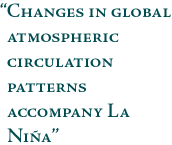 Changes in global atmospheric circulation patterns accompany La Niña and are
responsible for weather extremes in various parts of the world that are
typically opposite to those associated with El Niño. These patterns result from
colder than normal ocean temperatures inhibiting the formation of rain-producing
clouds over the eastern equatorial Pacific region while at the same time
enhancing rainfall over the western equatorial Pacific region (Indonesia,
Malaysia and northern Australia.) These patterns affect the position and
intensity (weakening) of jet streams and the behavior of storms outside of the
tropics in both the Northern and Southern hemispheres. Changes in global atmospheric circulation patterns accompany La Niña and are
responsible for weather extremes in various parts of the world that are
typically opposite to those associated with El Niño. These patterns result from
colder than normal ocean temperatures inhibiting the formation of rain-producing
clouds over the eastern equatorial Pacific region while at the same time
enhancing rainfall over the western equatorial Pacific region (Indonesia,
Malaysia and northern Australia.) These patterns affect the position and
intensity (weakening) of jet streams and the behavior of storms outside of the
tropics in both the Northern and Southern hemispheres.
The above image shows the sea surface height
and temperature difference from normal during January 1999, a period of La Niña.
Abnormally warm water (shown in yellow and red) expands and raises the surface of the ocean, while cool water
(shown in blue) shrinks. This can be seen in the trough of cool water extending westwards from South America.
(Image courtesy Greg Shirah, Scientific Visualization Studios)
U.S. La Niña Impacts
The first three months of the year during a La Niña typically feature below
normal precipitation in the Southwest, the central and southern sections of the
Rockies and Great Plains, and Florida. Meanwhile, the odds of surplus
precipitation increase across the Pacific Northwest, in the northern
Intermountain West, and over scattered sections of the north-central states,
Ohio Valley, and upper Southeast. La Niña features unusually cold weather in the
Northwest and (to a lesser extent) northern California, the northern
Intermountain West, and the north-central states. Farther south, higher than
normal temperatures are slightly favored in a broad area covering the southern
Rockies and Great Plains, the Ohio Valley, the Southeast, and the mid-Atlantic
states.
Global La Niña Impacts
Globally, La Niña is characterized by wetter than normal conditions west of the
equatorial central Pacific over northern Australia and Indonesia during the
northern hemisphere winter, and over the Philippines during the northern
hemisphere summer. Wetter than normal conditions are also observed over
southeastern Africa and northern Brazil, during the northern hemisphere winter
season. During the northern hemisphere summer season, the Indian monsoon
rainfall tends to be greater than normal, especially in northwest India. Drier
than normal conditions are observed along the west coast of tropical South
America, and at subtropical latitudes of North America (Gulf Coast) and South
America (southern Brazil to central Argentina) during their respective winter
seasons.

next: NASA and NOAA Missions to Study La Niña
back: The Southern Oscillation |
|

La Niña
The Southern Oscillation
The Effects of La Niña
NASA and NOAA Missions to Study La Niña
|


 Changes in global atmospheric circulation patterns accompany La Niña and are
responsible for weather extremes in various parts of the world that are
typically opposite to those associated with El Niño. These patterns result from
colder than normal ocean temperatures inhibiting the formation of rain-producing
clouds over the eastern equatorial Pacific region while at the same time
enhancing rainfall over the western equatorial Pacific region (Indonesia,
Malaysia and northern Australia.) These patterns affect the position and
intensity (weakening) of jet streams and the behavior of storms outside of the
tropics in both the Northern and Southern hemispheres.
Changes in global atmospheric circulation patterns accompany La Niña and are
responsible for weather extremes in various parts of the world that are
typically opposite to those associated with El Niño. These patterns result from
colder than normal ocean temperatures inhibiting the formation of rain-producing
clouds over the eastern equatorial Pacific region while at the same time
enhancing rainfall over the western equatorial Pacific region (Indonesia,
Malaysia and northern Australia.) These patterns affect the position and
intensity (weakening) of jet streams and the behavior of storms outside of the
tropics in both the Northern and Southern hemispheres.
